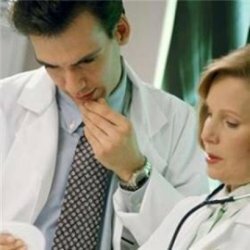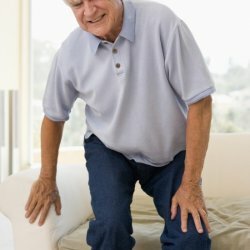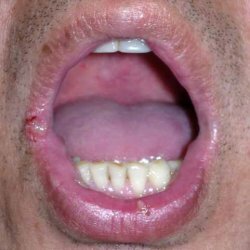Kashin-Bek disease
 Kashin-Bek disease is a degenerative disease in which the musculoskeletal system suffers. At the heart of this disease lies the primary disruption of the processes of ossification and the enchondral growth of tubular bones. Also, doctors consider this disease as an endemic deforming osteoarthritis.
Kashin-Bek disease is a degenerative disease in which the musculoskeletal system suffers. At the heart of this disease lies the primary disruption of the processes of ossification and the enchondral growth of tubular bones. Also, doctors consider this disease as an endemic deforming osteoarthritis.
This disease was first mentioned in 1839, but E. Beck and N. Kashin made a detailed description of it a few decades later. Most often, this disease occurs in the Transbaikal region near the River Level, so doctors call it a level disease. At the moment this disease is spread in other areas: China, Korea, in the area of Eastern Siberia.
The disease affects children and adolescents aged 6 to 14 years in a period of growth. When the patient is sick, doctors observe multiple symmetrical joint lesions, with the formation of various pronounced strains. The most characteristic symptoms of the disease are short-haired and short stature. This is due to the violation of bone growth.
What causes the disease?
To date, Kashin-Bek disease has not been studied to the end. There are several theories of its origin. The first theory suggests that the disease provokes a deficiency in the body of trace elements and calcium, as well as an increased content of iron, manganese and strontium in water, soil and foodstuffs, where foci of infection are fixed. In the bone tissue of patients, physicians found a high content of zinc, iron, silver and manganese in the study.
The imbalance of micro and macro elements in water, soil and food causes phosphate. At inspection in patients the raised maintenance of inorganic phosphorus in urine and blood has been revealed. This also causes changes in the joints and slow growth of the bones.
Some scientists have noticed that the parents who suffer from this disease are twice as likely to have children, who also later become ill with Kashin-Bek's disease. This proves a genetic predisposition. In addition, a disease such as rickets is a predisposing factor to the disease. In some cases, the disease provokes severe hypothermia or physical stress.
With this disease, there is a degenerative process in the joints and bones with a significant disruption of the processes of ossification. The metaphyses and epiphyses of long tubular bones are mainly affected. The defeat process begins with a dystrophic change in the metaepiphyseal bone. First there is calcification, then the cartilage is resorbed and replaced with bone tissue.
Initially, the zone of calcification is discharged, then this zone thickens and scleroses. After that, it gradually disappears. At the same time on the surfaces of the joint are formed multiple grooves, holes and furrows, which resemble vascular. As a result, the surface of the joints becomes porous, dug and deformed.
Due to the fact that all the above changes occur in the germ zone of the tubular bones and develop during the period of peak growth of the skeleton, the normal process of bone growth is disrupted, resulting in patients being stunted.
In later stages of the disease symptoms of deforming arthrosis appear, this leads to a change in the congruence of articular surfaces. There is peeling and destruction of articular cartilage. Deflection of articular surfaces leads to subluxation and displacement, as well as to dehydration and restriction of movement in the joint. If the load is distributed incorrectly, muscle contractures are formed. In rare cases, doctors detect symptoms of a reactive synovitis in patients with this disease. There is a deformation of the end plates of vertebral bodies with depressions in them and the introduction of intervertebral disc protrusions. The continuity of the plates is not violated.
Symptoms of the disease
The disease develops slowly. In the early stages of the patients' symptoms: non-permanent aching pain in muscles, joints, spine, crunch and stiffness in the joints, cramps and paresthesias in the calf muscles and toes. As a rule, first of all the interphalangeal joints of the hands are affected. When the disease progresses, elbow, wrist and other joints are affected. The joints are affected symmetrically and multitudinously. They gradually develop deformity, thickening, a slight muscle atrophy and limited mobility. Doctors often observe the curvature of the fingers and axes of the limbs. Joint pains are unstable and are noisy in nature, and they intensify in the evening or at night. If infringed "articular muscle," there is a blockade of joint syndrome - the patient feels a sharp pain and can not move a limb, in this case there is rapidly undergoing swelling.
There are three stages of the disease. At the first stage interphalangeal joints slightly thicken. In this case, the patient experiences painful sensations during exercise, as well as restriction of movement in the elbow, wrist and ankle joints. In the second stage, multiple joint damage and deformation occur, as well as thickening. The patient complains of a crunch and a restriction in the movements. Atrophy of muscle contracture and muscle also occurs. Develops short stature and short-haired. At the third stage, all joints are thickened and deformed. Movement in the joints is severely limited. Patients, doctors notice other symptoms: short neck, flat, bear paw, hyperlordosis lumbar duck gait and others.
In addition to the above symptoms in the second and third stages of the disease, patients may be observed: nervodistroficheskie disorders, heart pain, headaches, poor appetite, dull nails and hair, wrinkled skin, chronic atrophic rhinitis, otitis media, pharyngitis, bronchitis, gastritis, lung emphysema, Enterocolitis, myocardial dystrophy, vegetative vascular dystonia, deformation of jaws and teeth, encephalopathy. As the disease progresses, the patient's mental abilities decrease.
When studying the mineral composition of blood, it is found that the phosphorus content is underestimated, and the calcium content is too high.
Treatment of the disease
Treatment of this disease is aimed at improving the function of the joints, reducing pain and muscle contractures, as well as increasing the ability to work. With the timely treatment of the disease in the first stage, you can achieve a full recovery in 30% of cases. In later stages, it is possible to improve the mobility of the joints, reduce pain and slow the progression of the disease. This is achieved by the use of phosphorus and calcium preparations, vitamin C, B1, and the application of biological stimulators( ATP, aloe, FiBS, vitreous body).In addition to pharmacological treatment, doctors prescribe therapeutic gymnastics and massage. In addition, therapeutic compresses and radon baths are prescribed.
In the later stages of the disease, when pronounced, irreversible changes in the joints, doctors prescribe ortopedohirurgicheskoe treatment, using which it is possible to eliminate contractures and restore movement. If joint blockages are repeated, the articular niches are removed.



